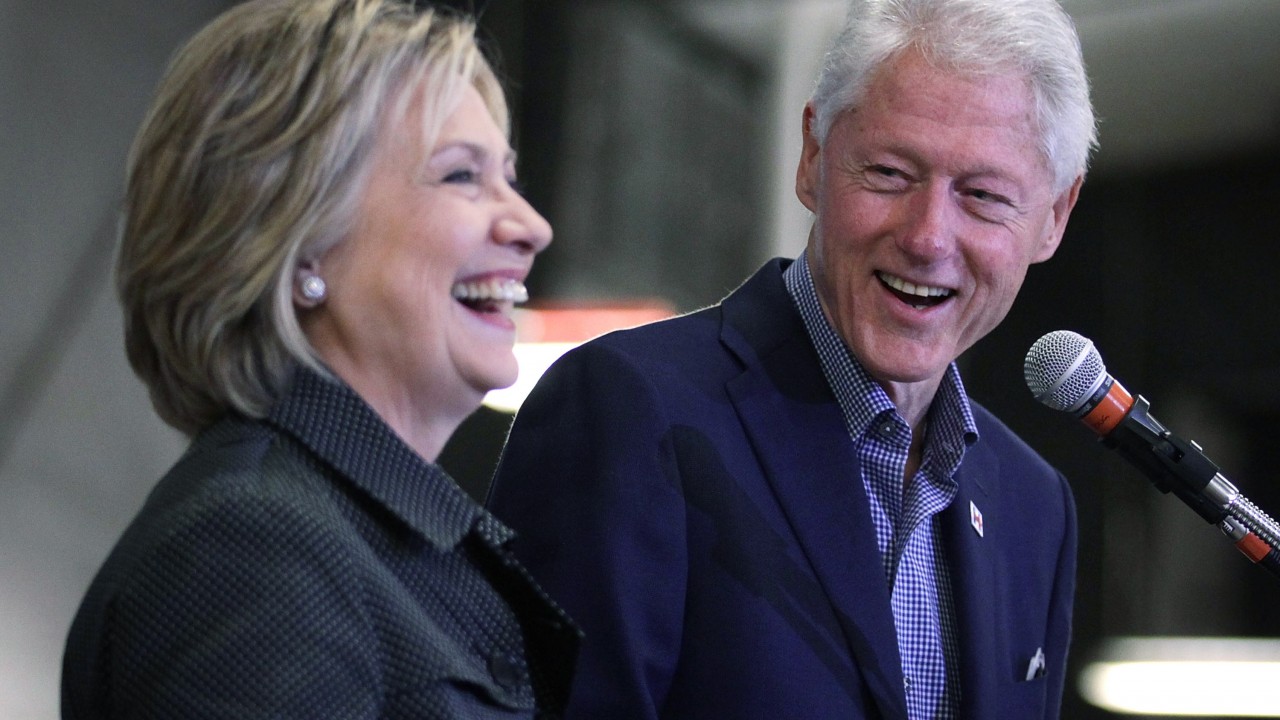
Hillary Clinton and her husband and former President Bill Clinton share a moment on stage during the Central Iowa Democrats fall barbecue, November 15, 2015. (Photo by Alex Wong/Getty Images)
This post originally appeared at The Nation.
Hillary Clinton’s recent op-ed in The New York Times, “How I’d Rein In Wall Street,” was intended to reassure nervous Democrats who fear she is still in thrall to those mega-bankers of New York who crashed the American economy. Clinton’s brisk recital of plausible reform ideas might convince wishful thinkers who are not familiar with the complexities of banking. But informed skeptics, myself included, see a disturbing message in her argument that ought to alarm innocent supporters.
Candidate Clinton is essentially whitewashing the financial catastrophe. She has produced a clumsy rewrite of what caused the 2008 collapse, one that conveniently leaves her husband out of the story. He was the president who legislated the predicate for Wall Street’s meltdown. Hillary Clinton’s redefinition of the reform problem deflects the blame from Wall Street’s most powerful institutions, like JPMorgan Chase and Goldman Sachs and instead fingers less celebrated players that failed. In roundabout fashion, Hillary Clinton sounds like she is assuring old friends and donors in the financial sector that, if she becomes president, she will not come after them.
The seminal event that sowed financial disaster was the repeal of the New Deal’s Glass-Steagall Act of 1933, which had separated banking into different realms: investment banks, which organize capital investors for risk-taking ventures; and deposit-holding banks, which serve people as borrowers and lenders. That law’s repeal, a great victory for Wall Street, was delivered by Bill Clinton in 1999, assisted by the Federal Reserve and the financial sector’s armies of lobbyists. The “universal banking model” was saluted as a modernizing reform that liberated traditional banks to participate directly and indirectly in long-prohibited and vastly more profitable risk-taking.
Exotic financial instruments like derivatives and credit-default swaps flourished, enabling old-line bankers to share in the fun and profit on an awesome scale. The banks invented “guarantees” against loss and sold them to both companies and market players. The fast-expanding financial sector claimed a larger and larger share of the economy (and still does) at the expense of the real economy of producers and consumers. The interconnectedness across market sectors created the illusion of safety. When illusions failed, these connected guarantees became the dragnet that drove panic in every direction. Ultimately, the federal government had to rescue everyone, foreign and domestic, to stop the bleeding.
Yet Hillary Clinton asserts in her Times op-ed that repeal of Glass-Steagall had nothing to do with it. She claims that Glass-Steagall would not have limited the reckless behavior of institutions like Lehman Brothers or insurance giant AIG, which were not traditional banks. Her argument amounts to facile evasion that ignores the interconnected exposures. The Federal Reserve spent $180 billion bailing out AIG so AIG could pay back Goldman Sachs and other banks. If the Fed hadn’t acted and had allowed AIG to fail, the banks would have gone down too.
These sound like esoteric questions of bank regulation (and they are), but the consequences of pretending they do not matter are enormous. The federal government and Federal Reserve would remain on the hook for rescuing losers in a future crisis. The largest and most adventurous banks would remain free to experiment, inventing fictitious guarantees and selling them to eager suckers. If things go wrong, Uncle Sam cleans up the mess.
That’s a hard sell in politics, given the banking sector’s bear hug of Congress and the White House, its callous manipulation of both political parties. Of course, it is more complicated than that. But recreating a safe, stable banking system — a place where ordinary people can keep their money — ought to be the first benchmark for Democrats who claim to be reformers.
— John Reed, former CEO of Citicorp
Actually, the most compelling witnesses for Sen. Warren’s argument are the two bankers who introduced this adventure in “universal banking” back in the 1990s. They used their political savvy and relentless muscle to seduce Bill Clinton and his so-called New Democrats. John Reed was CEO of Citicorp and led the charge. He has since apologized to the nation. Sandy Weill was chairman of the board and a brilliant financier who envisioned the possibilities of a single, all-purpose financial house, freed of government’s narrow-minded regulations. They won politically, but at staggering cost to the country.
Weill confessed error back in 2012: “What we should probably do is go and split up investment banking from banking. Have banks do something that’s not going to risk the taxpayer dollars, that’s not going to be too big to fail.”
John Reed’s confession explained explicitly why their modernizing crusade failed for two fundamental business reasons. “One was the belief that combining all types of finance into one institution would drive costs down — and the larger the institution the more efficient it would be,” Reed wrote in the Financial Times in November. Reed said, “We now know that there are very few cost efficiencies that come from the merger of functions — indeed, there may be none at all. It is possible that combining so much in a single bank makes services more expensive than if they were instead offered by smaller, specialised players.”
The second grave error, Reed said, was trying to mix the two conflicting cultures in banking — bankers who are pulling in opposite directions. That tension helps explain the competitive greed displayed by the modernized banking system. This disorder speaks to the current political crisis in ways that neither Dems nor Republicans wish to confront. It would require the politicians to critique the bankers (often their funders) in terms of human failure.
“Mixing incompatible cultures is a problem all by itself,” Reed wrote. “It makes the entire finance industry more fragile…. As is now clear, traditional banking attracts one kind of talent, which is entirely different from the kinds drawn towards investment banking and trading. Traditional bankers tend to be extroverts, sociable people who are focused on longer term relationships. They are, in many important respects, risk averse. Investment bankers and their traders are more short termist. They are comfortable with, and many even seek out, risk and are more focused on immediate reward.”
Reed concludes, “As I have reflected about the years since 1999, I think the lessons of Glass-Steagall and its repeal suggest that the universal banking model is inherently unstable and unworkable. No amount of restructuring, management change or regulation is ever likely to change that.”
This might sound hopelessly naive, but the Democratic Party might do better in politics if it told more of the truth more often: what they tried do and why it failed, and what they think they may have gotten wrong. People already know they haven’t gotten a straight story from politicians. They might be favorably impressed by a little more candor in the plain-spoken manner of John Reed.
Of course it’s unfair to pick on the Dems. Republicans have been lying about their big stuff for so long and so relentlessly that their voters are now staging a wrathful rebellion. Who knows, maybe a little honest talk might lead to honest debate. Think about it. Do the people want to hear the truth about our national condition? Could they stand it?
The views expressed in this post are the author’s alone, and presented here to offer a variety of perspectives to our readers.




